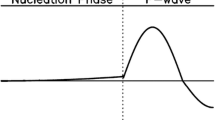Abstract
A better understanding of the nucleation process of an earthquake is of practical importance for early warning and hazard assessment. In present chapter, chaotic nucleation of an earthquake is investigated numerically using spring-mass slider with the rate- and state-dependent friction (RSF) law. The main focus during the numerical simulations is to identify the onset of chaotic motion showing irregular changes in frictional stress as well as slip velocity. It is observed that the chaotic tendency of the sliding system increases with number of state variables in the RSF model. Moreover, the stiffness at which chaos occurs also increases with number of the state variables. Thus, the present study justifies that the RSF laws could also be useful to study the multiscale nature of friction of hard surfaces such as metals and rocks.
Access this chapter
Tax calculation will be finalised at checkout
Purchases are for personal use only
Similar content being viewed by others
References
Brace WF, Byerlee JD (1966) Stick-slip as a mechanism of earthquake. Science 153:990–992
Dieterich JH (1979) Modeling of rock friction: 2. simulation of preseismic slip. J Geophys Res 84(B5):2169–2175
Dieterich JH (1979) Modeling of rock friction: 1. experimental results and constitutive equation. J Geophys Res 84(B5):2161–2168
Ruina AL (1983) Slip instability and state variable friction laws. J Geophys Res 88(B12):10359–10370
Gu JC, Rice JR, Ruina AL, Tse ST (1984) Slip motion and stability of a single degree of freedom elastic system with rate and state dependent friction. J Mech Phys Solids 32:167–196
Marone C (1998) Laboratory-derive friction laws and their application to seismic faulting. Ann Rev Earth Planet Sci 26:643–696
Rice JR, Ruina AL (1983) Stability of steady frictional slip**. J Appl Mech 50:343–349
Persson Bo NJ (2000) Sliding friction physical principal and application, 2nd ed. Springer, Berlin Heidelberg, New York
Gu Y, Wong T-F (1994) Nonlinear dynamics of the transition from stable sliding to cyclic stick-slip in rock in nonlinear dynamics and predictability of geophysical phenomena. In: Newman WI et al (eds) Geophysical monograph, vol 8. AGU, Washington, D.C., pp 15–35
Dieterich JH (1978) Time-dependent friction and the mechanics of stick-slip. In: Rock friction and earthquake prediction. Birkhäuser, Basel, pp 790–806
Niu ZR, Chen DM (1994) Period-doubling bifurcation and chaotic phenomena in a single degree of freedom elastic system with a two-state variable law. In: Nonlinear dynamics and predictability of geophysical phenomena. AGU geophysical monograph, vol 83, pp 75–80
Becker TW (2000) Deterministic chaos in two state-variable friction slider and effect of elastic interaction. Geocomplex Phys Earthq 120:5–26
Sinha N, Singh AK, Singh TN (2018) Effect of inertia, viscosity, temperature and normal stress on chaotic behaviour of rate state friction. J Earth Syst Sci 127:45. https://doi.org/10.1007/s12040-018-0935-2
Sinha N, Singh AK (2016) Linear and nonlinear stability analysis of rate state friction model with three state variables. Nonlinear Process Geophys Discuss https://doi.org/10.5194/npg-2016-11
Ellsworth WL, Beroza GC (1995) Seismic evidence for an earthquake nucleation phase. Science 268(5212):851–855
Rundle JB, Turcotte DL, Shcherbakov R, Klein W, Sammis C (2003) Statistical physics approach to understanding the multiscale dynamics of earthquake fault systems. Rev Geophys 41(4)
Shelly DR (2010) Periodic, chaotic, and doubled earthquake recurrence intervals on the deep San Andreas fault. Science 328(5984):1385–1388
Sobolev GA (2011) Seismicity dynamics and earthquake predictability. Nat Hazards Earth Syst Sci 11(2):445–458
Ampuero JP, Ripperger J, Mai PM (2006) Properties of dynamic earthquake ruptures with heterogeneous stress drop. In: Earthquakes: radiated energy and the physics of faulting, pp 255–261
Erickson B, Birnir B, Lavallée D (2008) A model for aperiodicity in earthquakes. Nonlinear Process Geophys 15:1–12
Zielke O, Galis M, Mai PM (2017) Fault roughness and strength heterogeneity control earthquake size and stress drop. Geophys Res Lett 44(2):777–783
Author information
Authors and Affiliations
Corresponding author
Editor information
Editors and Affiliations
Rights and permissions
Copyright information
© 2021 Springer Nature Singapore Pte Ltd.
About this paper
Cite this paper
Sinha, N., Singh, A.K., Vasudeo, A.D. (2021). The Effect of State Variables on Nucleation of Earthquake Using the Rate and State Friction. In: Kalamkar, V., Monkova, K. (eds) Advances in Mechanical Engineering. Lecture Notes in Mechanical Engineering. Springer, Singapore. https://doi.org/10.1007/978-981-15-3639-7_28
Download citation
DOI: https://doi.org/10.1007/978-981-15-3639-7_28
Published:
Publisher Name: Springer, Singapore
Print ISBN: 978-981-15-3638-0
Online ISBN: 978-981-15-3639-7
eBook Packages: EngineeringEngineering (R0)




